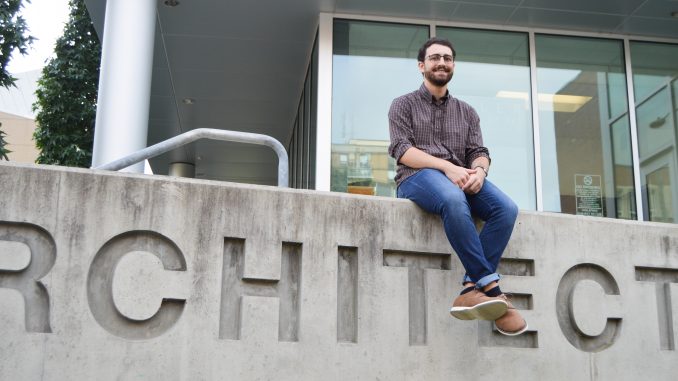
When David Donley and Michael Cinalli set out to harvest the wind, they wanted to benefit everyone.
In Spring 2018, several architecture students placed in the top 25 in the Land Art Generator Initiative, an international competition to design a clean power generating art installation in St Kilda, Australia. Two of the students were senior architecture major Donley and 2018 architecture alumnus Michael Cinalli, who qualified for their project proposal “Unwind.”
The project converts wind energy into electricity with kites that alternate unspooling. Donley and Cinalli designed the project to not only collect wind energy, but also engage viewers through its visual nature.
In “Unwind,” every generator attached to two kites, each on its own spool. Connected by a tether, one kite unspools at a time. Once one kite has flown through the length of its tether, it begins to move back down, allowing the second kite to unspool. As the second kite unspools, the other is pulled back in.
Both kites move in a figure-eight, “yo-yo” pattern. While some energy is lost to pull the kites back in, it’s offset by the amount of energy generated from the kites flowing upward.
Entries to the Land Art Generator Initiative could be for any type of renewable energy source, and at first Donley and Cinalli briefly considered methods like hydrogen, hydroelectric and geothermal power.
But those methods require a specific geographical landscape or an excessive amount of input energy, so the team decided to use wind for its practicality, efficiency and cost-effectiveness.
Donley and Cinalli then explored their options for harvesting the wind. They quickly dismissed using conventional methods like wind turbines, which wouldn’t be efficient or work in the St Kilda landscape.
After contemplating their options, the team opted for a novel approach: kites.
“It was a win-win situation,” Donley said. “The generator can be on the ground and the kites can also go to higher altitudes, where wind is more consistent. The amount of material being used is so much less than it would be for a horizontal wind turbine.”
Senior architecture major Kyle Taveira, who won fourth place in the competition for his project “Dreamtime,” said he found the project to be a more holistic approach to sustainable architecture.
“[Professors] encourage sustainability in our design, but it always seems like something that’s just applied at the end,” Taveira added.
“Dreamtime” generated wind energy by using energy-harvesting fabric ribbons attached to poles that look like the Aurora Borealis as they move in the wind. The poles generate and store the electricity.
“We’re so used to having windmills or wind turbines, but there are so many different ways to capture wind energy in itself,” Taveira said.
Eric Oskey introduced the students to the Land Art Generator Initiative in Spring 2018 while taking their senior architecture capstone course. Oskey, who taught the course, thought the competition would help students learn to combine their technical skills with their creativity.
“I wanted to find something that engaged the environment,” Oskey said. “The idea of sustainable design can be looked upon as necessary, because of all the changes in the environment, almost like it’s being forced upon us.”
Early on in Donley and Cinalli’s design process, Oskey was very impressed.
“They used technical skills along with the creative,” Oskey said. “They were being playful.”
According to the Global Wind Energy Council, the international trade association for the wind power industry, the amount of wind-harvesting projects installed annually worldwide increased 158 percent between 2007 and 2017. Donley said he believes the kite design will help reduce complaints from the public about the appearance of wind-harnessing tools.
“Beauty is in the eye of the beholder, so there’s going to be some people that say, ‘I don’t like that,’ but kites have been around for a long time,” he said. “Kites have been a part of culture and history.”
Oskey said he hopes to see his students’ innovative work extend beyond St Kilda.
“Sustainability doesn’t have to be boring,” he said. “The general public, even politicians, might find a way to be engaged in sustainable design. Its purpose is extremely valuable in this day and age we’re in now.”



Be the first to comment